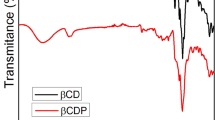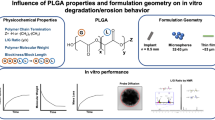Abstract
Bioresorbable materials are extensively used for a wide range of biomedical applications. Accurately modifying and evaluating the degradation rate of these materials is critical to their performance and the controlled release of bioactive agents. The aim of this work was to modify the physical properties, degradation rate and drug delivery characteristics of thin films for medical applications by blending poly(dl-lactic acid) (PDLLA), poly(l-lactide-co-glycolide) (PLGA) and poly(ε-caprolactone) (PCL). The thin films were prepared using solvent casting and compression moulding and the in vitro degradation study was performed by immersing the films in a phosphate-buffered saline at elevated temperature for a period of 4 weeks. The degradation rate of the materials was analysed by differential scanning calorimetry, tensile testing and weight loss studies. The thermal analysis of the blends indicated that the presence of PLGA or PDLLA in the film resulted in increased degradation of the amorphous regions of PCL. It was observed that the samples consisting of PDLLA with PCL demonstrated the greatest weight loss. The decrease in mechanical properties observed for both sets of polymer blends proved to be similar. The solvent cast technique was selected as the most appropriate for the formation of the polymer/drug matrices, due to the potentially adverse thermal processing effects associated with compression moulding. It was found that modulation of drug release was achievable by altering the ratio of PCL to PDLLA or PLGA in the thin film blends.







Similar content being viewed by others
References
Borden M (2006) Wiley encyclopedia of biomedical engineering. Wiley, New York
Lanza R, Langer R, Vacanti J (2007) Principles of tissue engineering. Elsevier Academic Press, New York
Gunatillake PA, Adhikari R (2003) Eur Cells Mater 5:1
Geever L, Devine D, Nugent M, Kennedy J, Lyons J, Higginbotham C (2006) Eur Polym J 42:69
Edlund U, Albertsson AC (2002) Adv Polym Sci 157:67
Pitt CG (1990) Biodegradable polymers as drug delivery systems. Marcel Dekker, New York, pp 71–120
Benoit MA, Baras B, Gillard J (1999) Int J Pharm 184:73
Lewis DH (1990) Biodegradable polymers as drug delivery systems. Marcel Dekker, New York, pp 1–41
Vert M (1996) The complexity of PLAGA-based drug delivery systems. In: Proceedings of the international conference on advances in controlled delivery, Baltimore MD, pp 32–36
Utracki LA (2002) Polymer blends handbook. Kluwer Academic Publishers, London
Chen C, Chueh J, Tseng H, Huang H, Lee S (2003) Biomaterials 24:1167
Lyons JG, Holehonnur H, Devine DM, Kennedy JE, Geever LM, Blackie P, Higginbotham CL (2007) Mater Chem Sci 103:419
Hukins DWL, Mahomed A, Kukureka SN (2008) Med Eng Phys 30:1270
Scott G, Gilead D (1995) Degradable polymers: principles and applications. Chapman & Hall, London
Gowariker VR, Viswanathan NV, Sreedhar J (1986) Polymer science. New Age International (P) Ltd, India
Lim LT, Auras R, Rubino M (2008) Prog Polym Sci 33:820
Saha SK, Tsuji H (2006) React Funct Polym 66:1362
Gupta AP, Kumar V (2007) Eur Polym J 43:4053
Liu C, Xia Z, Czernuszka JT (2007) Chem Eng Res Des 85:1051
Mathiowitz E (1999) Encyclopedia of controlled drug delivery, vol 1–2. Wiley, New York
Bajpai AK, Shukla SF, Bhanu S, Kankane S (2008) Prog Polym Sci 33:1088
Södergård A, Stolt M (2002) Prog Polym Sci 27:1123
Coombes AGA, Rizzi SC, Williamson M, Barralet JE, Downes S, Wallace WA (2004) Biomaterials 25:315
Langer R (1995) Chem Eng Sci 50:4109
Eastmond GC (1999) Adv Polym Sci 149:59
Yu PQ, Xie XM, Wang Z, Li HS, Bates FS (2006) Polymer 47:1460
Chouzouri G, Xanthos M (2006) Degradation of aliphatic polyesters in the presence of inorganic fillers. In: Proceedings of ANTEC 2006 Plastics, Annual Technical Conference Society of Plastics Engineers
Little U, Buchanan F, Harkin-Jones E, McCaigue M, Farrar D, Dickson G (2009) Polym Degrad Stabil 94:213
Reed AM, Gilding DK (1981) Polymer 22:499
Domb AJ (1993) J Polym Sci A Polym Chem 31
Chen DR, Bei JZ, Wang SG (2000) Polym Degrad Stabil 67:455
Koleshe JV (1978) Polymer blends, vol 2. Academic Press, New York
Jali R, Nixon JR (1990) J Microencapsul 7:297
Cao X, Shoichet MS (1999) Biomaterials 20:329
Kweon H, Yoo MK, Park IK, Kim TH, Lee HC, Lee HS, Oh JS, Akaike T, Cho CS (2003) Biomaterials 24:801
Tsuji H, Ikada Y (1996) J Appl Polym Sci 60:2367
Wnek G, Bowlin G (eds) (2008) Encyclopedia of biomaterials and biomedical engineering. Informa Health Care, UK
Li S, McCarthy S (1999) Biomaterials 20:35
Alexis F (2004) Polym Int 54:36
Rutkowska M, Krasowska K, Heimowska A, Steink A, Janik H, Karlsson S, Haponiuk J (2002) Pol J Environ Stud 11:413
Kelen T (1983) Polymer degradation. Van Nostrand Reinhold Company, New York
Pitt CG, Gratzl MM, Jeffcoat AR, Zweidinger R, Schindler A (1979) J Pharm Sci 68:1534
Heya T, Okada H, Ogawa Y, Toguchi H (1991) Int J Pharmaceut 72:199
Shen Y, Sun W, Zhu KJ, Shen Z (2000) J Biomed Mater Res 50:528
Godinho J, Moore I, Donnelly L, Lew CY, Douglas P, Jones D, McNally GM, Murphy WR (2005) Antec 2:3125
Acknowledgement
This study was supported in parts by grants from both Enterprise Ireland and the Athlone Institute of Technology research and development fund.
Author information
Authors and Affiliations
Corresponding author
Rights and permissions
About this article
Cite this article
McDonald, P.F., Lyons, J.G., Geever, L.M. et al. In vitro degradation and drug release from polymer blends based on poly(dl-lactide), poly(l-lactide-glycolide) and poly(ε-caprolactone). J Mater Sci 45, 1284–1292 (2010). https://doi.org/10.1007/s10853-009-4080-9
Received:
Accepted:
Published:
Issue Date:
DOI: https://doi.org/10.1007/s10853-009-4080-9




